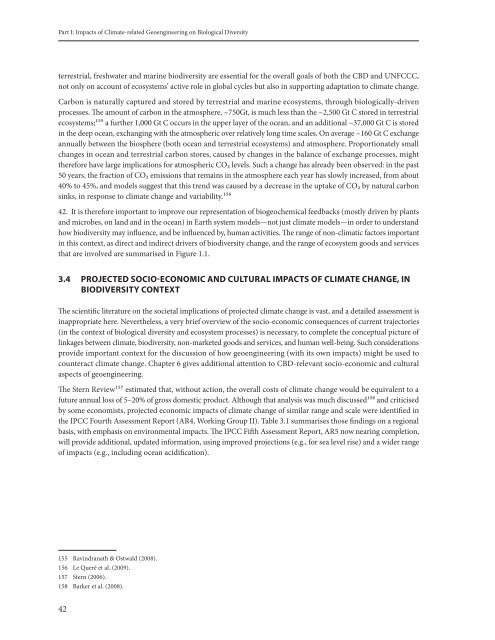cbd-ts-66-en
cbd-ts-66-en
cbd-ts-66-en
You also want an ePaper? Increase the reach of your titles
YUMPU automatically turns print PDFs into web optimized ePapers that Google loves.
Part I: Impac<strong>ts</strong> of Climate-related Geo<strong>en</strong>gineering on Biological Diversity<br />
terrestrial, freshwater and marine biodiversity are ess<strong>en</strong>tial for the overall goals of both the CBD and UNFCCC,<br />
not only on account of ecosystems’ active role in global cycles but also in supporting adaptation to climate change.<br />
Carbon is naturally captured and stored by terrestrial and marine ecosystems, through biologically-driv<strong>en</strong><br />
processes. The amount of carbon in the atmosphere, ~750Gt, is much less than the ~2,500 Gt C stored in terrestrial<br />
ecosystems;155 a further 1,000 Gt C occurs in the upper layer of the ocean, and an additional ~37,000 Gt C is stored<br />
in the deep ocean, exchanging with the atmospheric over relatively long time scales. On average ~160 Gt C exchange<br />
annually betwe<strong>en</strong> the biosphere (both ocean and terrestrial ecosystems) and atmosphere. Proportionately small<br />
changes in ocean and terrestrial carbon stores, caused by changes in the balance of exchange processes, might<br />
therefore have large implications for atmospheric CO2 levels. Such a change has already be<strong>en</strong> observed: in the past<br />
50 years, the fraction of CO2 emissions that remains in the atmosphere each year has slowly increased, from about<br />
40% to 45%, and models suggest that this tr<strong>en</strong>d was caused by a decrease in the uptake of CO2 by natural carbon<br />
sinks, in response to climate change and variability.156<br />
42. It is therefore important to improve our repres<strong>en</strong>tation of biogeochemical feedbacks (mostly driv<strong>en</strong> by plan<strong>ts</strong><br />
and microbes, on land and in the ocean) in Earth system models—not just climate models—in order to understand<br />
how biodiversity may influ<strong>en</strong>ce, and be influ<strong>en</strong>ced by, human activities. The range of non-climatic factors important<br />
in this context, as direct and indirect drivers of biodiversity change, and the range of ecosystem goods and services<br />
that are involved are summarised in Figure 1.1.<br />
3.4 PROJECTED SOCIO-ECONOMIC AND CULTURAL IMPACTS OF CLIMATE CHANGE, IN<br />
BIODIVERSITY CONTEXT<br />
The sci<strong>en</strong>tific literature on the societal implications of projected climate change is vast, and a detailed assessm<strong>en</strong>t is<br />
inappropriate here. Nevertheless, a very brief overview of the socio-economic consequ<strong>en</strong>ces of curr<strong>en</strong>t trajectories<br />
(in the context of biological diversity and ecosystem processes) is necessary, to complete the conceptual picture of<br />
linkages betwe<strong>en</strong> climate, biodiversity, non-marketed goods and services, and human well-being. Such considerations<br />
provide important context for the discussion of how geo<strong>en</strong>gineering (with i<strong>ts</strong> own impac<strong>ts</strong>) might be used to<br />
counteract climate change. Chapter 6 gives additional att<strong>en</strong>tion to CBD-relevant socio-economic and cultural<br />
aspec<strong>ts</strong> of geo<strong>en</strong>gineering.<br />
The Stern Review157 estimated that, without action, the overall cos<strong>ts</strong> of climate change would be equival<strong>en</strong>t to a<br />
future annual loss of 5–20% of gross domestic product. Although that analysis was much discussed158 and criticised<br />
by some economis<strong>ts</strong>, projected economic impac<strong>ts</strong> of climate change of similar range and scale were id<strong>en</strong>tified in<br />
the IPCC Fourth Assessm<strong>en</strong>t Report (AR4, Working Group II). Table 3.1 summarises those findings on a regional<br />
basis, with emphasis on <strong>en</strong>vironm<strong>en</strong>tal impac<strong>ts</strong>. The IPCC Fifth Assessm<strong>en</strong>t Report, AR5 now nearing completion,<br />
will provide additional, updated information, using improved projections (e.g., for sea level rise) and a wider range<br />
of impac<strong>ts</strong> (e.g., including ocean acidification).<br />
155 Ravindranath & Ostwald (2008).<br />
156 Le Queré et al. (2009).<br />
157 Stern (2006).<br />
158 Barker et al. (2008).<br />
42


